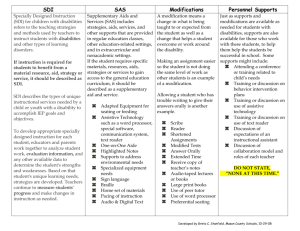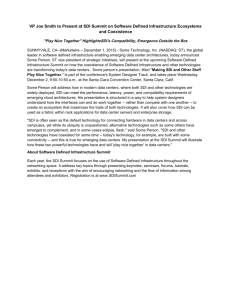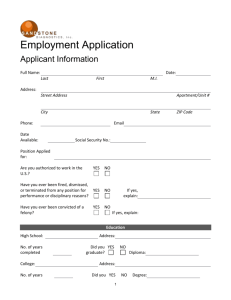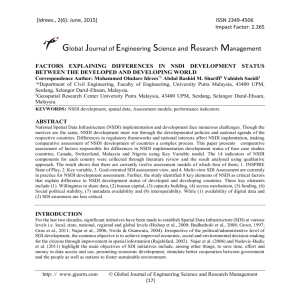State Spatial Data Infrastructure
advertisement
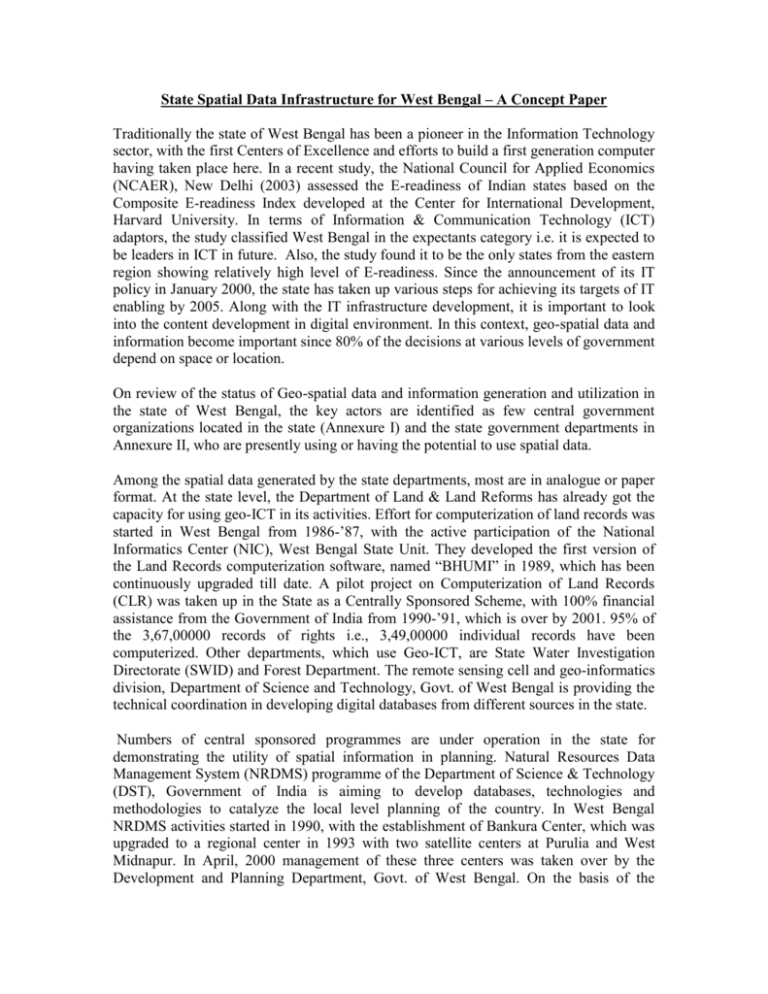
State Spatial Data Infrastructure for West Bengal – A Concept Paper Traditionally the state of West Bengal has been a pioneer in the Information Technology sector, with the first Centers of Excellence and efforts to build a first generation computer having taken place here. In a recent study, the National Council for Applied Economics (NCAER), New Delhi (2003) assessed the E-readiness of Indian states based on the Composite E-readiness Index developed at the Center for International Development, Harvard University. In terms of Information & Communication Technology (ICT) adaptors, the study classified West Bengal in the expectants category i.e. it is expected to be leaders in ICT in future. Also, the study found it to be the only states from the eastern region showing relatively high level of E-readiness. Since the announcement of its IT policy in January 2000, the state has taken up various steps for achieving its targets of IT enabling by 2005. Along with the IT infrastructure development, it is important to look into the content development in digital environment. In this context, geo-spatial data and information become important since 80% of the decisions at various levels of government depend on space or location. On review of the status of Geo-spatial data and information generation and utilization in the state of West Bengal, the key actors are identified as few central government organizations located in the state (Annexure I) and the state government departments in Annexure II, who are presently using or having the potential to use spatial data. Among the spatial data generated by the state departments, most are in analogue or paper format. At the state level, the Department of Land & Land Reforms has already got the capacity for using geo-ICT in its activities. Effort for computerization of land records was started in West Bengal from 1986-’87, with the active participation of the National Informatics Center (NIC), West Bengal State Unit. They developed the first version of the Land Records computerization software, named “BHUMI” in 1989, which has been continuously upgraded till date. A pilot project on Computerization of Land Records (CLR) was taken up in the State as a Centrally Sponsored Scheme, with 100% financial assistance from the Government of India from 1990-’91, which is over by 2001. 95% of the 3,67,00000 records of rights i.e., 3,49,00000 individual records have been computerized. Other departments, which use Geo-ICT, are State Water Investigation Directorate (SWID) and Forest Department. The remote sensing cell and geo-informatics division, Department of Science and Technology, Govt. of West Bengal is providing the technical coordination in developing digital databases from different sources in the state. Numbers of central sponsored programmes are under operation in the state for demonstrating the utility of spatial information in planning. Natural Resources Data Management System (NRDMS) programme of the Department of Science & Technology (DST), Government of India is aiming to develop databases, technologies and methodologies to catalyze the local level planning of the country. In West Bengal NRDMS activities started in 1990, with the establishment of Bankura Center, which was upgraded to a regional center in 1993 with two satellite centers at Purulia and West Midnapur. In April, 2000 management of these three centers was taken over by the Development and Planning Department, Govt. of West Bengal. On the basis of the success of these centers, the fourth NRDMS Centers have been established at Jalpaiguri district during June, 2001 on cost sharing basis of 25% of the State Govt. and 75% by the DST. Integrated Management for Sustainable Development (IMSD) and Natural Resource Information System (NRIS) are the two programmes of Department of Space, Govt. of India to proof the utility of space technology in natural resource management and planning. The NRDMS center in Bankura has established itself as a hub of spatial data capture and analysis to provide spatio-temporal information to the district authorities and district line departments for their planning requirements. The NRDMS center acts as repository of spatial and non-spatial data from different sources as listed in Annexure III. Many line departments are utilizing this database for rational decision-making. Block Medical Health Officer, Anchuri undertook reallocation of two Block Public Health sub-centres (BPHC) of Bankura-I Block under Jagadalla-II Gram Panchayat using the spatial data and analysis. Considering the criteria that no people should travel more than 2 kms from their village, from the BPHC location map it was found that the mouza Dadhimukha was in the commanding area of Helna Susunia Sub-centre (Figure 1.a) but the Service centre was inaccessible in comparison with the Sub-Centre Damodarpur which is nearer and more accessible. After analyzing the service area of each sub-centres in Anchuri with a criteria of maximum radial working distance of 1.6 km(Figure 1.b), Dadhimukha mouza was relocated in the commanding area of Damodar Sub-Cenre (Figure 1.c). Fig. 1.a Sub centres command area of Anchuri B.P.H.Cs (before re-allocation) Fig. 1.b Sub centres service area of Anchuri B.P.H.Cs (1.6 km. radial distance) Fig. 1.a Sub centres command area of Anchuri B.P.H.Cs (after re-allocation) Similarly the center’s services have been utilized by different line departments for law and order management, road planning, tribal development, natural resource management etc. The Department of Science & Technology is supporting IIT, Kharagpur to develop digital resource profile for the Midnapur district. Similar resources profile for Purulia has been developed through the NRIS programme. In spite of the above geo-spatial related activities and data availabilities, institutionalization of these data and information in decision making process are getting affected due to the following reasons : - No data catalogue is available, thus, we do not know which organization has what data. - Due to unavailability of metadata, it is difficult for users to know about the quality of the data and how they can access the available data. - There is no mechanism so that users can access available data from different sources as per their requirements. - The available and accessible data cannot be used in conjunction with others, since they follow multiplicity of standards in terms of scale, projection, standard, content, formats and quality. - Even if the data gets standardized there may be reluctance to share among organizations or may be restrictive policies. In order to overcome the above hindrances and take advantage of the available plethora of spatial and non-spatial data for better and efficient decision making for good governance, there is an urgent need to develop a state level Spatial Data Infrastructure (SDI). What is SDI? The term "Spatial Data Infrastructure" (SDI) is often used to denote the relevant base collection of technologies, policies and institutional arrangements that facilitate the availability of and access to spatial data. The SDI provides a basis for spatial data discovery, evaluation, and application for users and providers within all levels of government, the commercial sector, the non-profit sector, and academia and by citizens in general. The word infrastructure is used to promote the concept of a reliable, supporting environment, analogous to a road or telecommunications network, that, in this case, facilitates the access to geographically-related information using a minimum set of standard practices, protocols, and specifications. The spatial data infrastructure (SDI) concept continues to evolve, as it becomes a core infrastructure, supporting economic development, environmental management and social stability in the developed and the developing countries alike (Williamson, Rajabifard and Feeney 2003). Hierarchy of SDI As a result of developing SDIs at different levels by different nations and organisations, a model of SDI hierarchy that includes SDIs developed at different political-administrative levels have been developed and introduced by Rajabifard and Williamson. This model presents an SDI hierarchy is made up of inter-connected SDIs at corporate, local, state or provincial, national, regional and global levels. Global SDI Regional SDI National SDI State SDI Local SDI Corporate SDI According to this hierarchy model, there are top down and bottom up views of multi level SDI development, which interlinks each hierarchic level in two ways. Based on these two views, the SDI hierarchy creates an environment, in which decision-makers working at any level can draw on data from other levels, depending on the themes, scales, currency and coverage of the data needed. Components of SDI With respect to core components, an SDI encompasses the policies, access networks and data handling facilities (based on the available technologies), standards, and human resources necessary for the effective collection, management, access, delivery and utilization of spatial data for a specific jurisdiction or community. The essential component can be listed as below: Core / framework Geospatial Datasets : Common themes of data needed by different Governments for good governance. Every nation or organization decides on their Framework. Policy : Policy to facilitate data access to users. Metadata : Data about data, helps to locate, evaluate, extract and employ right data for right purpose by various users. Standards: Required to Provide an understanding of data around the globe and across communities. Standarisation in data, hardware, software and process help in facilitating exchange of information and its analysis across different communities. Clearinghouse: Distributed, electronically connected network of geospatial data which can be made available through a common window. Organizational framework: Issues related to governance, data sharing and cost recovery. Resources / Partnerships: Capacity building of human resources, cooperation among organizations and outreach. Indian NSDI initiative Considering the need in the country, an initiative is being taken to develop National Spatial Database Infrastructure (NSDI) for India by Department of Science and Technology and Department of Space in collaboration with several stakeholders of spatial community like: Ministry of Rural Development Ministry of Urban Development Ministry of Environment and Forests Department of Information Technology Survey of India Geological Survey of India Registrar General and Census Commissioner of India National Natural Resource Management System Natural Resource Database Management Systems Forestry Survey of India National Atlas and Thematic Mapping Organisation National Remote Sensing Agency Indian Metrology Department National Informatics Centre The NSDI vision are 1) to develop National infrastructure for the availability of and access to organised spatial data and 2) Use of the infrastructure at Community, Local, State, Regional and National levels for sustained economic growth. The NSDI is an overarching framework for the existing agencies with the authority to mandate constituent agencies to commit their data sets and generate new data on the basis of user needs. Possible partners of State SDI in West Bengal. The SDI initiative has the goal to create an environment or a framework where all stakeholders can cooperate and interact with each other with the relevant technologies in order to meet objectives at different political and administrative levels. Coordination, cooperation and sharing among different participant agencies are the essence of it. In the context of West Bengal SDI (WBSDI) the central coordination could be provided by Department of Development & Planning on administrative issues and Department of Science & Technology on technological issues. Central organizations located in the state should contribute data, information and knowledge and key state departments dealing with spatial data like DLRS, Irrigation, PWD, panchayat etc. should be the initial partners, which will gradually encompass all the departments. Following figure illustrates the possible coordination and sharing mechanism. DLRS SWID FSI SOI NATMO NBSSLUP ps GSI Mines & Minerals Panchayat WBSDI (Dev.& Planning and WBDST) PWD Other Depts… n RRSSC NRSA Census of India ndevelopment Approach / road map for State SDI n of SDI, road map for development of WBSDI may In the context of different components be consider as follows: n NRDMS NRIS Development of Core / framework Geospatial Datasets: Survey of India should supply the basics of framework datasets i.e. geodetic framework. Standarised core digital datasets for all the 18 districts should be developed. While core datasets at 1:50,000 scale are available for Bankura, Puruliya, Midnapur and Jalpaiguri districts, it needs to be developed for other districts with the help of various participating organizations. Average cost for developing core datasets for one district would be Rs. 25.00 lakhs. Policy guidelines: State has a proactive IT policy. However, availability and accessibility of digital data will be guided by central policies like recent map policy and NSDI bill which is going to be issued shortly. The state may need to develop its own digital data policy pertinent to the data not coming under the purview of NSDI. Cataloguing of spatial data: In order to assess the availability of spatial data with different central and state government agencies and departments, it is necessary to develop a data catalogue. State Department of Science & Technology should do it in a project mode with the assistance of Central Department of Science & Technology. Metadata and Standards: The National Spatial Data Exchange (NSDE) should be adopted as standard data exchange format. While standardization of data in different sectors developed at national level should be adopted. Metadata format developed for NSDI should be adopted. Each of the state departments generating spatial data should develop their metadata information. Development of Clearing house: Pilot scale clearing house linking the spatial data generating central and state organizations, as well as the districts should be developed. In this regard a project should be developed in association with Central DST. Organisational partnership framework: In order to coordinate geo-spatial activities in the state of West Bengal for development of WBSDI, a state level coordination committee should be constituted under the chairmanship of the Minister-in-charge , Development and Planning, Government of West Bengal and the other relevant departments should be the members in the committee. Capacity building: In order to build up the awareness and capacity of different stakeholders at different level in the concept of SDI, training workshops should be organised regularly. Annexure I Organisations Survey of India (SOI) National Atlas Thematic Mapping Organisation (NATMO) Geological Survey of India (GSI) National Bureau of Soil Survey and Land Use Planning (NBSSLUP) Forest Survey of India (FSI) Regional Remote Sensing Service Centre (RRSSC), Kharagpur Sectors Topo maps at scale of 1:50 & 25,000 Thematic maps, district planning series maps for selected districts. Geological maps Soil maps Forest maps Services related to space technologies. Annexure II Department Land & Land Reform Police Department PWD Election Irrigation & Water ways Agri-Irrigation Detailed Soil Survey and Planning District Industries Centre Education SWID Electricity Animal Husbandry Health Public Health Engineering Municipality Geology Mines & Mineral Food & Supply Co-operative Societies Spatial Layer Sub-Division boundary, Block boundary, Block Head Quarter, Gram-Panchayat Boundary, Gram Panchayat Head Quarter, Mouza Boundary, Circle Boundary, Police Station Boundary with Head Quarter, Outposts, Crime prone area Road: Metalled, Unmetalled, Water bound Macadam, Cart-Tarck Parliamentary Constituencies, Assembly Constituencies, Polling Stations Canal System, Dam, Barrage, Rivers, Streams Catchment area and command area of irrigation Micro-watershed Boundary, Land use Location of Small Scale Industries Schools (Primary, Secondary & Higher Secondary), Sishu Sikshya Kendra (SSK) Location of Permanent Hydrographic Stations, ground water fluctuation maps and hydro-geomorphology maps. Existing & Proposed of Electric Supply Office, SubStations, Electric Line ( 220 kv, 132 kv, 33/11 kv) District Veterinary Hospital, State Animal Health Centre, Block Livestock Development Officer, Block Animal Health Centre, Addl. Block Animal Health Centre, Animal Aid Centre, Chilling Plant, Liquid Nitrogen Plant, Veterinary Pathologist Location of ICDS Centres, Medical College, SubDivision Hospitals, BPHC, PHC, Sub Centre, Homoeopathic Centres, Ayurvedic Dispensory, Leprosy Control Unit, TB Centres Tube Well, Well, Hand Pump, Rig Bore Tube well &Command area of piped water supply scheme Ward Boundary Alluvium, Laterite, Pancht Sandstone shales, Raniganj Sandstone shale with coalseams, Anorthosites and related rocks, Calc-Granulites and other calcareous rocks, basic Rocks, Granite gneiss porphyritic, granite, Pegmatite, Schistose rocks (Mica Schist), Quarzite Road metal, Decorative Stone, China Clay, Coal, Copper, Dumortlerite, Galena, Dolomitic Lime Stone, Mica, Quartzite, Magnetite, Tangsten Ore, Quartz , Vermiculite, Quartz Felsper Location of Ration Dealers, FCI Godowns Location of Co-operative Societies with their command Fishery Forest Panchayat area Water bodies Area of Dense forest, degraded forest & Social Forest, location of Forest protection Committees Location of Self Help Groups exist, Status of Below Poverty Line (BPL) families Source: NRDMS center, Bankura Annexure III Description Topography Spatial Contours Geology Geological Map Physiography 1. Dissected Plateau 2. Flood Plain 3. Lower Alluvial Plain 4. Residual Hillocks & Mounts 5. Settlement 6. Upper undulating Alluvial Plain Mineral Map Mineral Resources Waste Land Soils Micro watershed Landuse Forest 1. Upland with Scrub 2. Upland without scrub 3. Eroded Land 4. Sand Soil Series Association Mini Watershed 1. Double Crop (Paddy+Paddy) 2. Double Crop (Paddy + Potato) 3. Kharif crop 4. River Grass 5. Settlement 6. Bushes / Village Orchard 1. Dense Forest Non-Spatial Height of Contours Polygon referring to rocks Source S.O.I. Toposheet Mines and Minerals Deptt., Govt. W.B. National Buraeu of Soil Survey and Land use Planning, Nagpur Names of minerals found its location and amount of deposit Directorate of Mines and Minerals, Govt. W.B. Bankura IRS-1C/1D Satellite Image (1999) Soil Series – Physical Chemical Properties National Bureau of Soil Survey and Land use Planning, Nagpur IIT, Delhi Watershed Data IRS-1C/1D Satellite Image (1999) Name of division, IRS-1C/1D 2. Degraded Forest 3. Open Forest Ground Water Surface water (Drainage) Surface water bodies Hydrology map with water table Surface water boundary, Canal Location of bodies Administrative Mouza boundaries, Settlement, Road & Rail Amenities Educational institutions, Health centers, Warehouses range, beat, block etc., age group wise distribution sal & Coppice tree upto 10 years high-forest etc. Details of depth of water Name of surface water boundary Location code of water bodies, seasonal uses of water Name of Mouzas &Gram Panchayats, Census data-2001 Associated data. Satellite Image (1999) SWID SWID SWID NATMO, PWD and Census2001 NATMO, Health, Education departments. Source: NRDMS center, Bankura
